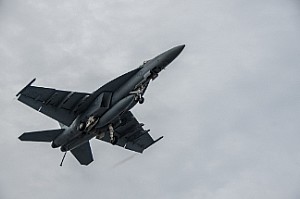Navy.mil Home Page
An Update from the Navy's Aviation Energy Conservation Program
SAN DIEGO (NNS) -- Naval Aviation is part of the Secretary of the Navy's (SECNAV) Energy Conservation Program.
The Aviation Energy Conservation (Air ENCON) Program is designed to optimize fuel consumption by naval aviation units-without adversely impacting safety or mission execution-to ensure the right amount of fuel is available for sustained mission readiness. Air ENCON focuses on operational awareness and practices that will conserve fuel and improve efficiency to not only protect finite resources, but to ensure warfighting capability.
The Air ENCON Program was initiated by the Aviation Working Group (AWG) of Task Force Energy. The AWG is charged with developing strategies and initiatives to implement Navy energy goals within the Naval Aviation community, including developing operational energy conservation measures, as well as technologies designed to reduce energy consumption across the Naval Aviation Enterprise.
To ensure the success of the Air ENCON Program, an Integrated Project Team comprised of members from Commander, Naval Air Force, Pacific, Commander, Naval Air Force, Atlantic and Naval Air Systems Command (NAVAIR) has been established to oversee the development of the program, design an effective implementation strategy, and manage sustainment of energy conservation initiatives.
Positive program effects are already occurring in the fleet. Short-Cycle Mission and Recovery Tanking (SMART) for example, offers operators an option for airborne tanking operations at sea. SMART, or any of the many hybrid variations, improves efficiencies. CNAF and NAVAIR accelerated "Magic Carpet" technology for F/A-18 E/F Super Hornets and EA-18G Growlers which will further reduce tanking requirements and add efficiencies to aircraft carrier recovery operations.
Program awareness is the first, and perhaps, most important factor in advancing SECNAV's mandate. Fleet Energy Training Symposiums in San Diego, California; Norfolk, Virginia; Jacksonville, Florida; and Yokosuka, Japan, have educated a wide audience and engaged all warfighting communities in open discussion. Naval aviation is also being incorporated into the annual SECNAV Energy Award program, which will recognize squadrons who have implemented fuel-saving measures into their operations and provide monetary awards.
Additionally, units that are deployed next year will participate in the Great Green Fleet 2016, demonstrating energy conservation measures that are consistent with operational readiness requirements during deployed operations and further exploring the potential for the operational use of biofuels. Information on the Great Green Fleet can be found at http://greenfleet.dodlive.mil/energy/great-green-fleet/.
Visit the Air ENCON website at http://airencon.dodlive.mil/ for information on the Navy's energy goals as well as information on the Air ENCON Program. The SharePoint site at https://cpf.portal.navy.mil/sites/cnap/N40/encon/default.aspx provides specific details on energy conservation measures and provides the opportunity to comment, ask questions or submit suggestions for conserving fuel.
For more news from Commander, Naval Air Forces, visit www.navy.mil/local/airpac/.





 To sign up for updates or to access your subscriber preferences, please click on the envelope icon in the page header above or click
To sign up for updates or to access your subscriber preferences, please click on the envelope icon in the page header above or click